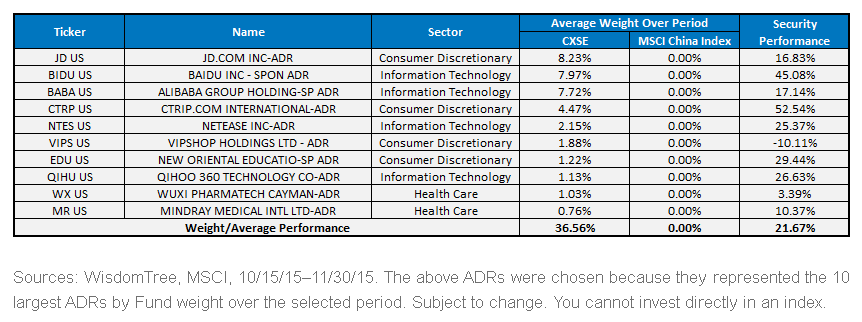CXSE: A Tactical Opportunity ahead of MSCI Rebalance


 Visit the CXSE page for current holdings.
Bottom Line
WisdomTree believes investors in Chinese ETFs should re-evaluate their exposures to China. The long-term motivation is that we believe the sector exposures in CXSE are more consistent with the economic policy and changes occurring in the region. But there is also some additional timely motivation that suggests now would be a very good time to make the switch—ahead of the second tranche of ADRs being added to the MSCI China Index, given the large weight these stocks represent in CXSE.
1Sources: WisdomTree, Bloomberg, refers to the Shanghai Composite Index level high on 6/12/15.
2Sources: WisdomTree, Bloomberg, 10/15/15–11/30/15.
3Source: MSCI, as of 3/31/16.
Visit the CXSE page for current holdings.
Bottom Line
WisdomTree believes investors in Chinese ETFs should re-evaluate their exposures to China. The long-term motivation is that we believe the sector exposures in CXSE are more consistent with the economic policy and changes occurring in the region. But there is also some additional timely motivation that suggests now would be a very good time to make the switch—ahead of the second tranche of ADRs being added to the MSCI China Index, given the large weight these stocks represent in CXSE.
1Sources: WisdomTree, Bloomberg, refers to the Shanghai Composite Index level high on 6/12/15.
2Sources: WisdomTree, Bloomberg, 10/15/15–11/30/15.
3Source: MSCI, as of 3/31/16.
Important Risks Related to this Article
Double-digit returns were achieved primarily during favorable market conditions. Investors should not expect that such favorable returns can be consistently achieved. A fund’s performance, especially for very short periods, should not be the sole factor in making your investment decision.
Past performance is not indicative of future results.
There are risks associated with investing, including possible loss of principal. Foreign investing involves special risks, such as risk of loss from currency fluctuation or political or economic uncertainty. The Fund focuses its investments in China, thereby increasing the impact of events and developments associated with the region, which can adversely affect performance. Investments in emerging or offshore markets are generally less liquid and less efficient than investments in developed markets and are subject to additional risks, such as risks of adverse governmental regulation and intervention or political developments.
The Fund’s exposure to certain sectors may increase its vulnerability to any single economic or regulatory development related to such sectors. As this Fund can have a high concentration in some issuers, the Fund can be adversely impacted by changes affecting those issuers. Please read the Fund’s prospectus for specific details regarding the Fund’s risk profile.

Jeremy Schwartz has served as our Global Chief Investment Officer since November 2021 and leads WisdomTree’s investment strategy team in the construction of WisdomTree’s equity Indexes, quantitative active strategies and multi-asset Model Portfolios. Jeremy joined WisdomTree in May 2005 as a Senior Analyst, adding Deputy Director of Research to his responsibilities in February 2007. He served as Director of Research from October 2008 to October 2018 and as Global Head of Research from November 2018 to November 2021. Before joining WisdomTree, he was a head research assistant for Professor Jeremy Siegel and, in 2022, became his co-author on the sixth edition of the book Stocks for the Long Run. Jeremy is also co-author of the Financial Analysts Journal paper “What Happened to the Original Stocks in the S&P 500?” He received his B.S. in economics from The Wharton School of the University of Pennsylvania and hosts the Wharton Business Radio program Behind the Markets on SiriusXM 132. Jeremy is a member of the CFA Society of Philadelphia.

